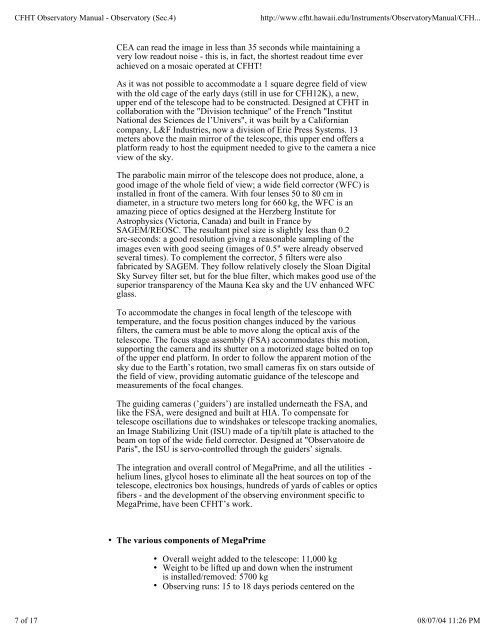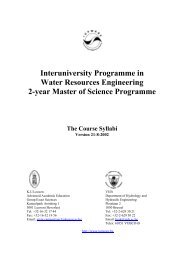CFHT operating manual - Homepage Usask
CFHT operating manual - Homepage Usask
CFHT operating manual - Homepage Usask
You also want an ePaper? Increase the reach of your titles
YUMPU automatically turns print PDFs into web optimized ePapers that Google loves.
<strong>CFHT</strong> Observatory Manual - Observatory (Sec.4) http://www.cfht.hawaii.edu/Instruments/ObservatoryManual/CFH...<br />
CEA can read the image in less than 35 seconds while maintaining a<br />
very low readout noise - this is, in fact, the shortest readout time ever<br />
achieved on a mosaic operated at <strong>CFHT</strong>!<br />
As it was not possible to accommodate a 1 square degree field of view<br />
with the old cage of the early days (still in use for CFH12K), a new,<br />
upper end of the telescope had to be constructed. Designed at <strong>CFHT</strong> in<br />
collaboration with the "Division technique" of the French "Institut<br />
National des Sciences de l’Univers", it was built by a Californian<br />
company, L&F Industries, now a division of Erie Press Systems. 13<br />
meters above the main mirror of the telescope, this upper end offers a<br />
platform ready to host the equipment needed to give to the camera a nice<br />
view of the sky.<br />
The parabolic main mirror of the telescope does not produce, alone, a<br />
good image of the whole field of view; a wide field corrector (WFC) is<br />
installed in front of the camera. With four lenses 50 to 80 cm in<br />
diameter, in a structure two meters long for 660 kg, the WFC is an<br />
amazing piece of optics designed at the Herzberg Institute for<br />
Astrophysics (Victoria, Canada) and built in France by<br />
SAGEM/REOSC. The resultant pixel size is slightly less than 0.2<br />
arc-seconds: a good resolution giving a reasonable sampling of the<br />
images even with good seeing (images of 0.5" were already observed<br />
several times). To complement the corrector, 5 filters were also<br />
fabricated by SAGEM. They follow relatively closely the Sloan Digital<br />
Sky Survey filter set, but for the blue filter, which makes good use of the<br />
superior transparency of the Mauna Kea sky and the UV enhanced WFC<br />
glass.<br />
To accommodate the changes in focal length of the telescope with<br />
temperature, and the focus position changes induced by the various<br />
filters, the camera must be able to move along the optical axis of the<br />
telescope. The focus stage assembly (FSA) accommodates this motion,<br />
supporting the camera and its shutter on a motorized stage bolted on top<br />
of the upper end platform. In order to follow the apparent motion of the<br />
sky due to the Earth’s rotation, two small cameras fix on stars outside of<br />
the field of view, providing automatic guidance of the telescope and<br />
measurements of the focal changes.<br />
The guiding cameras (’guiders’) are installed underneath the FSA, and<br />
like the FSA, were designed and built at HIA. To compensate for<br />
telescope oscillations due to windshakes or telescope tracking anomalies,<br />
an Image Stabilizing Unit (ISU) made of a tip/tilt plate is attached to the<br />
beam on top of the wide field corrector. Designed at "Observatoire de<br />
Paris", the ISU is servo-controlled through the guiders’ signals.<br />
The integration and overall control of MegaPrime, and all the utilities -<br />
helium lines, glycol hoses to eliminate all the heat sources on top of the<br />
telescope, electronics box housings, hundreds of yards of cables or optics<br />
fibers - and the development of the observing environment specific to<br />
MegaPrime, have been <strong>CFHT</strong>’s work.<br />
The various components of MegaPrime<br />
Overall weight added to the telescope: 11,000 kg<br />
Weight to be lifted up and down when the instrument<br />
is installed/removed: 5700 kg<br />
Observing runs: 15 to 18 days periods centered on the<br />
7 of 17 08/07/04 11:26 PM

















